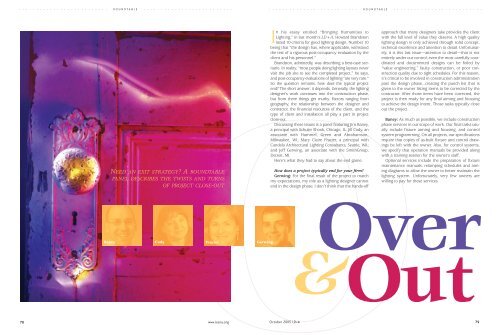P R O G R E S S R E P O R T - Illuminating Engineering Society
P R O G R E S S R E P O R T - Illuminating Engineering Society
P R O G R E S S R E P O R T - Illuminating Engineering Society
You also want an ePaper? Increase the reach of your titles
YUMPU automatically turns print PDFs into web optimized ePapers that Google loves.
. . . . . . . . . . . . . . . . . . . . . . . . . . . . R O . U . N . D T . A . B . L E. . . . . . . . . . . . . . . . . . . . . . . . . . . . . . . . . . . . . . . . . . . . . . . . . . . . . . . . R O . U . N . D . T A . B . L E. . . . . . . . . . . . . . . . . . . . . . . . . . . .<br />
NEED AN EXIT STRATEGY? A ROUNDTABLE<br />
PANEL DESCRIBES THE TWISTS AND TURNS<br />
OF PROJECT CLOSE-OUT<br />
In his essay entitled “Bringing Humanities to<br />
Lighting,” in last month’s LD+A, Howard Brandston<br />
listed 10 criteria for good lighting design, Number 10<br />
being that “the design has, where applicable, withstood<br />
the test of a rigorous post-occupancy evaluation by the<br />
client and his personnel.”<br />
Brandston, admittedly, was describing a best-case scenario.<br />
In reality, “most people doing lighting layouts never<br />
visit the job site to see the completed project,” he says,<br />
and post-occupancy evaluations of lighting “are very rare.”<br />
So the question remains, how does the typical project<br />
end? The short answer: it depends. Generally, the lighting<br />
designer’s work continues into the construction phase,<br />
but from there things get murky. Factors ranging from<br />
geography, the relationship between the designer and<br />
contractor, the financial resources of the client, and the<br />
type of client and installation all play a part in project<br />
close-out.<br />
Discussing these issues is a panel featuring Jim Baney,<br />
a principal with Schuler Shook, Chicago, IL; Jill Cody, an<br />
associate with Hammel, Green and Abrahamson,<br />
Milwaukee, WI; Mary Claire Frazier, a principal with<br />
Candela Architectural Lighting Consultants, Seattle, WA;<br />
and Jeff Gerwing, an associate with the SmithGroup,<br />
Detroit, MI.<br />
Here’s what they had to say about the end game.<br />
How does a project typically end for your firm?<br />
Gerwing: For the final result of the project to match<br />
my expectations, my role as a lighting designer cannot<br />
end in the design phase. I don’t think that the hands-off<br />
approach that many designers take provides the client<br />
with the full level of value they deserve. A high quality<br />
lighting design is only achieved through solid concept,<br />
technical excellence and attention to detail. Unfortunately,<br />
it is this last issue—attention to detail—that is not<br />
entirely under our control; even the most carefully coordinated<br />
and documented designs can be foiled by<br />
“value engineering,” faulty construction, or poor construction<br />
quality due to tight schedules. For this reason,<br />
it’s critical to be involved in construction administration<br />
past the design phase...creating the punch list that is<br />
given to the owner listing items to be corrected by the<br />
contractor. After those items have been corrected, the<br />
project is then ready for any final aiming and focusing<br />
to achieve the design intent. Those tasks typically close<br />
out the project.<br />
Baney: As much as possible, we include construction<br />
phase services in our scope of work. Our final tasks usually<br />
include fixture aiming and focusing, and control<br />
system programming. On all projects, our specifications<br />
require that copies of as-built fixture and control drawings<br />
be left with the owner. Also, for control systems,<br />
we specify that operation manuals be provided along<br />
with a training session for the owner’s staff.<br />
Optional services include the preparation of fixture<br />
maintenance manuals, relamping schedules and aiming<br />
diagrams to allow the owner to better maintain the<br />
lighting system. Unfortunately, very few owners are<br />
willing to pay for these services.<br />
Baney Cody Frazier Gerwing<br />
Over<br />
Out<br />
&<br />
78 www.iesna.org October 2005 LD+A 79

















